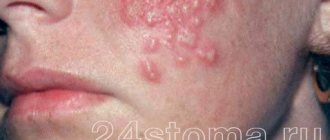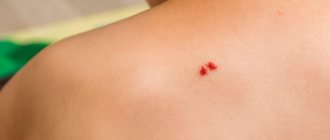Symptoms
Clinical manifestations of meningitis in children are determined by the virulence of the pathogen, age and state of immunity. There are some differences in symptoms and treatment methods among different age groups. Pathological changes consist of a combination of syndromes: cerebral, infectious and meningeal.
The first signs of meningococcal infection
Menigococcal meningitis develops when meningococci enter the body. In 80% of cases, children under 10 years of age become ill.
It is characterized by sudden fever, bursting headache, which is accompanied by repeated vomiting, photophobia. The child becomes lethargic very quickly. There is a decrease in the threshold of sensitivity, when even a light touch causes severe pain; in infants it manifests itself as general anxiety. In the first hours of the disease, meningeal syndromes appear.
Meningococcal infection is characterized by a forced position, when a child, lying on his back or side, throws back his head and pulls his legs towards his stomach.
Symptoms of meningitis in young children appear gradually. The child becomes restless, emits a sharp cry, vomits, and convulsions occur. There is hyperthermia, a hemorrhagic rash, and a venous network is visible on the head. On examination, the large fontanel is tense and pulsating.
It is necessary to urgently seek medical help if a child has the following symptoms and signs against a background of fever:
- tension of the large fontanelle;
- involuntary muscle twitching;
- the nature of the cry has changed;
- photophobia;
- repeated vomiting;
- constriction of the pupils, squint;
- muscle atony.
In infants, often the only symptom of infection is a bulging or pulsating fontanel.
For pneumococcal pathogens
Pneumococcal meningitis is caused by pneumococci. It ranks second in incidence after meningococcal. More often diagnosed in children under 5 years of age.
The disease with a pneumococcal pathogen has several forms, which determine the first signs of meningitis in children.
To identify meningitis in a school-age child at the initial stage, you should pay attention to the following symptoms:
- occurs in an acute form;
- body temperature suddenly rises to 39-40 C;
- intoxication increases rapidly;
- consciousness is impaired;
- pale skin, cyanosis of the nasolabial triangle, shortness of breath, arrhythmia appear;
- the child reacts negatively to light and noise;
- meningococcal syndrome is weakly or incompletely expressed.
In children under one year of age, a recurrent form is often found. It is characterized by a gradual increase in toxicosis, retraction of the large fontanel. The liver and spleen enlarge, motor activity is impaired. Relapses last from 5 to 10 days, accompanied by periodic fever and deterioration.
Tuberculous meningitis
Tuberculous meningitis is the most dangerous form of tuberculosis, which usually develops as a secondary process against the background of pulmonary tuberculosis.
The spread of infection occurs by hematogenous or lymphogenous route.
Pulmonary tuberculosis does not manifest itself in any way for a long time, which is why therapy is not carried out, and the risk of generalization of the infection increases. This risk is absent in children vaccinated in the maternity hospital with the BCG anti-tuberculosis vaccine.
What do parents need to know about meningitis?
28.06.2018 Meningitis-
This is an inflammation of the soft membranes of the brain and spinal cord caused by various pathogens.
Causes of meningitis:
· Viruses (eg, measles, chickenpox, mumps). · Bacteria (for example, meningococcus, pneumococcus, Haemophilus influenzae and others). · Fungi.
All types of meningitis have symptoms that are common to common infections. It is almost impossible to identify the cause of the disease without laboratory diagnostics.
Meningococcal infection
is one of the most pressing problems, with approximately half a million cases reported annually worldwide, one in ten of which are fatal. Death in 63% of cases occurred on the first day from the onset of the disease, even with timely seeking medical help, most of them were children under 2 years of age. In 20% of cases after meningococcal infection, the outcome was disability (loss of hearing, vision, mental retardation, amputation of limbs).
Meningococcal infection
is an acute infectious disease caused by the bacterium meningococcus.
The disease can manifest itself in different ways:
- Asymptomatic carriage (meningococci can inhabit the human nasopharynx and any of us can be a potential carrier; carriage is more common in adults and adolescents, who are the source of infection for children),
- Mild respiratory infection (nasopharyngitis),
- Severe forms of infection (meningitis, sepsis).
Who can get sick?
Meningococcal meningitis can occur in any person - a child of the first year of life, a teenager and an adult. Meningococcal infection is especially dangerous for children. In more than 90% of cases, healthy children without additional risk factors get sick; the incidence of children under 4 years of age is 22 times higher than in adults!
Sources of infection.
The disease spreads from person to person through coughing, sneezing, kissing, and even talking or sharing cutlery. Since infection occurs through close contact, the main source of infection for young children is their parents, brothers and sisters, relatives, as well as other children in nurseries and kindergartens.
Risk factors for meningococcal infection:
- child's age up to 4 years;
- visiting a kindergarten or school;
- cramped living conditions: in a family, in dormitories, barracks, boarding schools, orphanages, sanatoriums, pioneer camps, etc.;
- external factors leading to a weakening of the immune system (including stress, hypothermia, overwork);
- congenital and acquired disorders of the immune system, damage or absence of the spleen;
- traveling to places where meningococcal infection is widespread (some African countries, Saudi Arabia).
1. Fever.
One sign of meningitis is a fever that starts suddenly. The child begins to tremble and complains that he is cold all the time.
The patient's temperature quickly rises, which can be difficult to bring down. But since this symptom is a sign of many diseases, you should also pay attention to other features in the change in the child’s condition.
2. Headache.
Headache with meningitis is often not just severe, but almost unbearable. In this case, the pain often also constrains the patient’s neck, but due to the fact that the patient’s head literally “splits,” he may not pay attention to it.
In newborns, a characteristic sign is also a bulge in the area of the large fontanelle and a high-pitched cry.
3. Double vision.
A patient with meningitis cannot focus his vision, which is why the image in his eyes constantly doubles.
4. Abdominal pain, nausea and vomiting, sudden loss of appetite.
5. Photosensitivity.
Another sign of meningitis is a fear of bright light, which can cause the child's eyes to water, as well as worsening nausea and headaches.
6. Stiff neck.
A child with meningitis is in a special recognizable position: lying on his side with his head thrown back and legs bent. When he tries to straighten his neck, he often fails.
7. Inability to straighten your legs.
Even if it is possible to tilt the child’s head to the chest, his legs immediately bend at the knees, which are impossible to straighten in this position. This phenomenon is called upper Brudzinski syndrome.
With meningitis, Kernig's syndrome also appears along with it. With it, it is impossible to straighten the leg at the knee if it is raised approximately 90°.
8. Skin rashes do not turn pale.
With meningitis, skin rashes are also possible. A simple test can help distinguish them from rashes that are not associated with meningitis. Take a glass of clear glass, apply it to the rash and press so that the skin under the glass turns pale. If the rash also turns pale, it means there is no meningitis. If the rash has retained its color, you should be wary.
How to protect your child from meningococcal infection?
It is impossible to completely protect a child from contact with infections. Therefore, vaccination is carried out to protect against infectious diseases. A child can be vaccinated against meningococcal infection in the first year of life (from 9 months).
Children from the risk group are subject to vaccination (see above).
Facts about meningitis vaccines.
Meningococcal vaccines do not contain live bacteria and cannot cause meningococcal disease in unvaccinated people.
Vaccines create an immune response even in young children, which will protect the child from a dangerous infection as early as possible.
The vaccine provides a stable immune “barrier” against meningococcal infection 10 days after vaccination.
The vaccine also reduces the carriage of bacteria in the nasopharynx. By vaccinating yourself, adults can prevent transmission of bacteria to young children, who are at particular risk!
There are several types (serotypes) of meningococcus, the most common of which are A, B, C, Y and W. That is why it is advisable to choose vaccines that include the maximum number of meningococcal serotypes for more reliable protection against infection. The Menactra vaccine, approved in the Russian Federation, meets these requirements.
, providing protection against serotypes A, C, Y, W-135 (made in the USA).
Vaccination schedule
from 9 months. up to 23 months twice, with an interval of at least 3 months; from 2 years to 55 years once. Revaccination is not required.
The Baxero vaccine can protect against serotype B, which is widespread in Russia.
, but the drug is not registered in the Russian Federation. Maybe someday it will appear here too, but we shouldn’t expect it in the coming years. Two European countries have included Bexero in their national vaccination schedules - the UK and the Czech Republic. Vaccination of Russians with this drug is possible in European countries at their own expense (vaccine tourism).
In the pediatric department of Clinical Hospital No. 122, vaccination against meningitis is carried out by the head of the pediatric department, pediatrician, pulmonologist L.V. Marshalkovskaya. and pediatrician, allergist-immunologist Pereverzeva Yu.S.
The material was prepared by a pediatrician, allergist-immunologist
Pereverzeva Yulia Sergeevna
.
To prepare the material, the following sources were used: Pediatrics according to Nelson, 17th edition, 244, p. 398, Internet sources: https://www.privivka.ru/meningit, https://www.adme.ru.
Regarding vaccination against meningitis
at the pediatric department of clinical hospital No. 122
please contact us by phone:
+7(812)363-11-22;
+7(812) 558-99-76,
Pediatric department
How to recognize a viral infection?
Meningitis of viral etiology is seasonal, with outbreaks occurring in winter and spring. It is caused by various types of viruses: mumps, adenoviruses, enteroviruses and others.
In childhood, meningitis of mumps and enterovirus etiology is more common.
The main signs of meningitis in children 5 years old:
- temperature increase;
- stunnedness (slowing down of mental processes);
- strabismus;
- impaired movement of the eyeballs;
- convulsions.
With mumps meningitis, the clinical picture has features that make it possible to recognize the disease in a child. With this form of infection, the manifestations at different ages are somewhat different.
Hallucinations, delirium, weakness, impaired motor activity, fever are signs of meningitis in children 3 years of age and younger. There is also an increase in headaches and an enlargement of the salivary glands.
Pancreatitis, voluntary muscle movements, in boys, swelling of the scrotum, its redness are additional symptoms of meningitis in children 7-8 years old.
Typical symptoms of enterovirus infection are muscle pain, especially in the abdominal area, fever, herpetic rashes, bursting headache, and dyspeptic disorders. Simultaneously with the high temperature, redness of the face appears, with pallor of the nasolabial triangle, a polymorphic rash, symptoms of conjunctivitis, and hyperemia of the pharynx.
Meningeal signs
The meningeal symptom complex is based on muscular-tonic syndrome, which occurs due to irritation of the nerve receptors of the meninges. Main meningeal syndromes:
- Kernig. The patient lies on his back, the leg is bent at the knee at a right angle, due to strong muscle tension, it is impossible to completely straighten the limb.
- Bekhterev. It is determined by percussion of the zygomatic bone; when it is beaten, the facial muscles of the face contract, due to increased headaches.
- Mandonesi. Pressure on the eyeballs causes contraction of the facial muscles.
- Brudzinsky. The bottom symptom is that if you straighten one leg, the patient will involuntarily pull up the other limb. Upper – when trying to tilt the patient’s head to the chest, flexion of the lower extremities is observed.
- Lesage. Determined in infants. If the symptom is positive, the child, lifted by the armpits, pulls the legs towards the stomach and holds them in this position.
- Flatau. When the head is tilted forward, the pupil dilates.
- Stiffness of the neck muscles. The earliest and most permanent sign of the disease. When trying to raise the head of a patient lying on his back, a sharp resistance is felt, the action fails, or the upper part of the body rises.
The presence of meningeal signs is the main indication for lumbar puncture and cerebrospinal fluid assessment. But it doesn’t always mean meningitis; they are also typical for other infectious diseases!
Nature of the rash
A rash with meningitis in children usually appears in the fulminant form of the disease. It consists of small pinpoint hemorrhages that appear towards the end of the 1st and beginning of the 2nd day of illness. The earlier the rash appears, the more severe the disease. It occurs on the entire surface of the skin, but is more abundant on the buttocks, eyelids, back of the legs, and thighs.
The rash has the shape of stars protruding above the skin level and is dense to the touch. In mild forms of the disease, the rash lasts no more than 2 days; in severe forms, it persists for up to several weeks.
Where does the disease come from?
By its origin, serous meningitis can be:
- Primary – brain damage directly from a viral or bacterial attack.
- Secondary - develops against the background of another disease that causes a weakened immune system.
The causative agents of the disease can be:
- viruses;
- bacteria;
- fungi.
According to medical statistics, among childhood morbidity, viral pathogens account for 80% of cases of serous meningitis. Children of preschool age - from three to six years old - are susceptible to inflammation of the meninges. Schoolchildren and adults to a lesser extent.
Acute serous meningitis is most often caused by enteroviruses. Among them, there are two main ones: the ECHO virus and the Coxsackie virus.
In more rare cases, the reasons are:
- Epstein-Bar virus (is the causative agent of infectious mononucleosis);
- cytomegalovirus;
- herpes;
- measles;
- influenza viruses (especially highly mutagenic ones).
In medicine, there are three ways of transmitting the disease:
- Contact – with a handshake and other touches by the wearer. In the latter, the virus is most often localized on the hands, skin lesions, mucous membranes of the mouth and eyes.
- Airborne - concentration of the virus in the respiratory tract. It is transmitted by inhaling air that contains saliva particles containing the pathogen in the form of an aerosol.
- Alimentary (fecal-oral) method - a susceptible organism ingests water contaminated with enteroviruses. In recent years, outbreaks of meningitis have become common in the summer, when the swimming season is in full swing. The infection, entering the child’s mouth with water, accumulates in the intestines. Later it is excreted in feces and again ends up in the water.
Enteroviruses retain their vital functions on food products for a long time. Personal hygiene, thorough washing of vegetables and fruits reduce the risk factor.
The incubation period of the disease varies from several hours (acute form) to several days. In this case, the first symptoms of serous meningitis in children may appear only a week after the direct infection.
How does it manifest in newborns?
Many parents are interested in the question of how meningitis manifests itself in infants, because they cannot make complaints, and the disease is dangerous and poses a threat to life.
Meningitis in newborns is accompanied by characteristic symptoms:
- dyspepsia;
- monotonous scream;
- hyperexcitability;
- frequent regurgitation;
- twitching of hands and chin;
- vomit;
- throwing back the head;
- loss of appetite;
- low-grade fever;
- increased muscle tone.
The same symptoms occur after severe birth injuries and hypoxia, so an accurate diagnosis is made only after examining the cerebrospinal fluid.
The disease in newborns and children in the first months of life occurs with severe intoxication, muscle hypotonia, respiratory failure, and repeated convulsions are possible.
How to protect yourself from illness
All parents should pay attention to the prevention of serous meningitis in children. In the summer, you should listen to local news - if an outbreak of meningitis follows after visiting open water, you should not allow your child to swim there.
Measures to combat the disease are generally reduced to maintaining hygiene rules:
- Drink boiled or specially purified water. This rule should be taken especially seriously by those who live in low-lying areas where wastewater may enter the water intake.
- Follow the rules of personal hygiene - be sure to wash your hands after visiting the toilet and before eating.
- Wash vegetables and fruits before eating (especially in the summer). Products can additionally be doused with boiling water - enteroviruses are afraid of high temperatures.
- Meningitis can develop against the background of other viral diseases - measles, mumps, influenza and even common ARVI. Therefore, be attentive to the follow-up treatment and recovery of your child after any such illness.
- If a baby has a weak immune system, he should not come into contact with rodents (even domestic ones), as they are considered carriers of serous meningitis pathogens.
Meningitis is a complex disease. Due to the carelessness of parents, the disease often has the most disastrous consequences. But if you raise the alarm in time and go to a medical facility, serous meningitis will go away quite quickly - in 10-12 days. And don’t forget about prevention – it’s better not to get sick at all.
When the first symptoms of the disease appear, contact an infectious disease specialist online or at a good infectious diseases hospital.
For more information about meningitis in children, watch the video:
This article has been verified by a current qualified physician, Victoria Druzhikina, and can be considered a reliable source of information for site users.
Bibliography
1. https://niidi.ru/dotAsset/e3e1899f-a522-4aa4-acd2-f28dedca3bc0.pdf
Rate how useful this article was
4 3 people voted, average rating 4
Did you like the article? Save it to your wall so you don’t lose it!
Can it be determined during the incubation period?
The incubation period for bacterial meningitis lasts 2–7 days, for a viral infection it lasts 2–4 days. In infants it may be less than a day. Its duration largely depends on the state of the child’s immunity; the stronger it is, the longer there are no clinical manifestations.
It is very difficult to determine the disease during this period. Clinical manifestations are very vague or completely absent. But parents should pay attention to changes in the child’s behavior: sudden drowsiness, lethargy, increasing headache, nausea, loss of appetite - may be the first signals of a dangerous infection.
Diagnosis of meningitis
The main methods for diagnosing meningitis include:
- Cerebrospinal fluid examination. Cerebrospinal fluid is obtained using a lumbar puncture. When diagnosing meningitis, various fluid characteristics are determined (transparency and color, number and composition of cells, amounts of protein, glucose, and the presence of microflora), which make it possible to identify changes characteristic of meningitis.
- X-ray of the skull.
- Fundus examination.
- Computer and nuclear magnetic resonance tomography.
- Electroencephalography.
The diagnosis of meningitis is established based on a combination of 3 signs:
- Presence of symptoms of meningitis.
- Signs of infection.
- The presence of characteristic changes in the cerebrospinal fluid.
Treatment
If meningitis is suspected, urgent hospitalization to the infectious diseases department is indicated.
For bacterial meningitis, treatment includes:
- antibacterial therapy;
- anticonvulsants;
- non-steroidal anti-inflammatory drugs;
- detoxification therapy;
- antihistamines;
- corticosteroid hormones.
Treatment of meningitis of viral etiology does not require antibiotics. Recombinant interferon, acyclovir, and immunomodulators are used. Infusion and desensitizing therapy are also carried out. After receiving the results of bacteriological culture, therapy is adjusted depending on the pathogen.
The duration of treatment depends on the clinical course of the infection. For meningococcal meningitis, antibiotic therapy lasts 6-10 days, for other etiologies 8-14 days. Treatment begins with intravenous administration of antibiotics and continues until the temperature drops persistently, then switches to oral administration or intramuscular injections of drugs.
Consequences
Severe consequences of meningitis are more often recorded in young children and with delayed treatment.
If the diagnosis is not made on time and therapy is delayed, dangerous complications develop: sepsis, endocarditis, pneumonia, abscess or cerebral edema.
The most common consequences of meningitis suffered in childhood:
- hydrocephalus;
- mental retardation;
- epileptic seizures;
- paresis;
- decreased or loss of hearing;
- damage to the cranial nerves.
Even with a successful outcome, after discharge the child experiences asthenoneurotic conditions: sleep disturbance, anxiety, headaches, memory loss, fatigue.
Prevention measures
Prevention of meningitis depends on the etiology. Patients are urgently hospitalized and isolated. Persons in contact with the sick person are examined for carriage and observed for 10 days.
To prevent a dangerous disease, immunization is carried out. There are several vaccines, both foreign and Russian. For example, the imported vaccine against pneumococcal meningitis “Prevenar” is approved for children from 3 months of age. Well tolerated and does not cause side effects. After completing the full course of vaccination, by the age of two years the child develops stable immunity.
Vaccinations against meningococcal infection are carried out with the Russian vaccine from 1.5 years, and the American vaccine from 2 years.
Vaccination is not included in the scheduled vaccination calendar; it is carried out according to indications or at the personal request of the parents.







